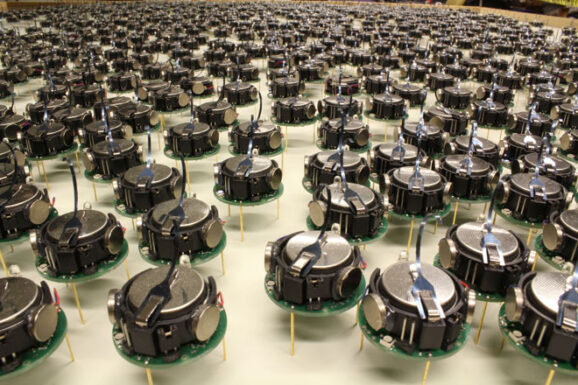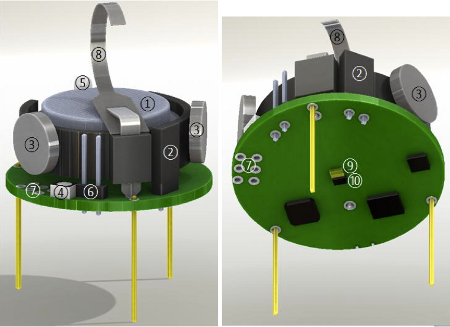Scientists Program The Biggest Group Of Robots Ever
 Swarming robots — on the ground, in the air, even in a swimming pool — are nothing new, and DARPA put out a call back in May for robots to work together in a hive-mind sort of way. Still, all of those developments put together didn’t quite prepare me for the massive swarm of robots that scientists have recently programmed.
Swarming robots — on the ground, in the air, even in a swimming pool — are nothing new, and DARPA put out a call back in May for robots to work together in a hive-mind sort of way. Still, all of those developments put together didn’t quite prepare me for the massive swarm of robots that scientists have recently programmed.
The robot is called Kilobot — a name that makes sense metrically, but also has some unfortunate connotations, especially when spoken out loud. It was created by researchers at Harvard’s Self-Organizing Systems Research Group. It’s roughly the size of a penny and has three toothpicks for legs. The parts to build a Kilobot cost about $14, and by itself it doesn’t seem all that commanding or impressive. But when amassed with 1,000 other Kilobots, the tiny robots transform into a collaborative mass that can assemble itself into pretty much any two-dimensional shape it wants.
Nothing to this scale has ever been done before. Scientists have programmed a couple hundred robots to work together, but never more than 1,000. One of the keys is simplicity. While fancier parts might aid in self-assembly, they make manufacturing more difficult and costly, especially in such great numbers. At the same time, a robot that’s too rudimentary won’t be able to perform as necessary, so the researchers had to land somewhere in the middle, combining individual simplicity with collaborative capabilities. They give the robot swam instructions via overhead infrared lights, and from there the robots communicate with each other via infrared signals. In their ground-breaking new demonstration, they show how 1,024 robots can work together to form the letter K, a wrench, and a star.

While the shapes made by the Kilobots might not seem all that impressive just yet, it’s not hard to imagine what they’ll be able to do in the future. Such algorithms could be used for driverless cars and programmable matter — basically, any three-dimensional object you can think of. Or, if you consider each tiny robot to be akin to a cell that works with a structure’s basic biology, the Kilobot could comprise a bigger ‘bot that can change shape at will to perform tasks. The concept demonstrated here could conceivably work with swarms of 10,000 robots or more. Hold on to your hats — and your kids!












